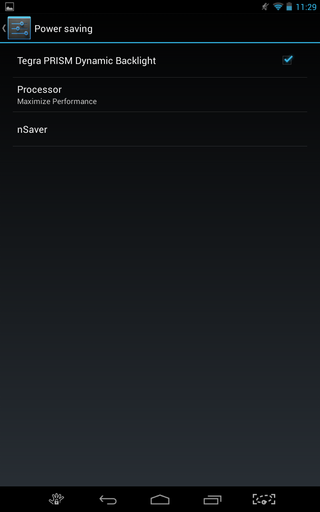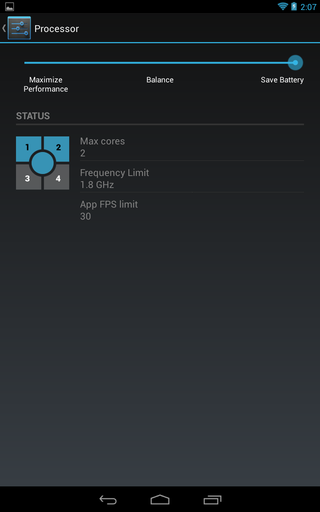EVGA Tegra Note 7 Review: Nvidia's Tegra 4 For $200
Nvidia is partnering with EVGA on the company's second Tegra 4-based device. Its Tegra Note 7 sells for $200, sports unique stylus technology, and ships with a bloatware-free build of Android. Can it set a new standard for affordable seven-inch tablets?
Almost-Stock Android And Some Unique Settings
As with Shield, Nvidia's packages its own version of Android with the Tegra Note 7. The company refers to this as "stock Android," and although it's close, the operating system isn't entirely stock in the same sense that Nexus devices run stock Android.
From a user standpoint, the version of Android on Tegra Note 7 looks and behaves very much like the base Android environment. However, its updates come from Nvidia instead of Google, which means it'll always be slightly behind the Nexus update schedule. Case in point, the Tegra Note 7 ships with Android 4.2.2, though Nvidia tells us that an OTA update to 4.3 is currently targeted for December. Today, Android 4.4 (KitKat) is running on the Nexus 5, and by next month the Nexus 4, Nexus 7, and Nexus 10 will all be on the new version.
Semantics aside, we're not docking points for Nvidia's Note not being as current as the Google-supported devices. My personal tastes steer me clear of the custom UI and features implemented by manufacturers trying to cultivate their own brand. The clean and uncluttered implementation you get with the Tegra Note 7 benefits the user in its standardized look and efficiency, while Nvidia can push updates out much quicker with minimal customization efforts.

With that said, there are a few device-specific additions worth talking about. In the settings is a Power Savings menu that we didn't see on Shield. Inside, you'll find a toggle to enable or disable Nvidia's PRISM (Pixel Rendering Intensity and Saturation Management) technology, change processor behavior, and manage nSaver.
PRISM, which now unfortunately shares a name with the NSA surveillance program, is a Tegra-specific feature introduced last generation that can also be found on the 2012 Nexus 7. Nvidia tells us PRISM is enabled on Shield as well. But on Tegra Note 7, it can also be turned off if you so wish. According to Nvidia, "PRISM reduces display power consumption by reducing backlight brightness while dynamically increasing pixel intensity." It's important to note that this feature is completely separate from auto-brightness, which adjusts according to ambient lighting rather than what's on-screen.
In practice, I find PRISM to be a little distracting, as the shift between light and dark scenes on-screen, even while browsing, causes distinct changes in brightness. While this is the feature working as intended, I prefer to set the brightness to a static level and leave it there. Thankfully, Nvidia gives us complete control over the feature. So, anyone looking to really optimize battery life can leave it on. And, in fact, our battery tests demonstrate that PRISM does extend up-time in a pretty spectacular way.


There's also a processor setting that lets you switch between three modes: Maximum Performance, Balance, and Save Battery. The screenshots above and below illustrate how each setting differs. In our testing, there was no discernible performance delta between Maximum Performance and Balance under load, though halving the cores in Save Battery mode definitely has an impact on speed and battery life.
Stay on the Cutting Edge
Join the experts who read Tom's Hardware for the inside track on enthusiast PC tech news — and have for over 25 years. We'll send breaking news and in-depth reviews of CPUs, GPUs, AI, maker hardware and more straight to your inbox.

In our conversations with Nvidia about our findings, we learned that the Balance mode responds to utilization by ramping the SoC's frequency up and down. For example, if Tegra 4's processor cores are fully utilized, and the current clock rate is lower than peak, it scales up to its 1.8 GHz ceiling until utilization falls. By then backing off, Balance mode helps increase battery life in more casual use cases like video playback, reading, and even light gaming.

Finally, there's the nSaver feature, which allows you to individually control background activity on an app-by-app basis. nSaver is able to identify apps that are particularly demanding and give you the option to throttle them.
Current page: Almost-Stock Android And Some Unique Settings
Prev Page Nvidia Tegra Note 7: A $200 Tegra 4-Based Tablet Next Page Computational Photography, Camera Awesome, And Audio-
DelightfulDucklings Performance wise it is very good for the price seemingly but I just hate the design, to me it just looks plain uglyReply -
JD88 Front facing speakers are really nice. One of the very few complaints I have about my Nexus 7 is volume.Reply
This thing is a powerhouse for the money. -
ananke No 1080p, no sales. Otherwise great device, and good price, but DOA because of the screen. The Chinese knock offs will outsell it.Reply -
TheSchmed I am considering buying this tablet, but I'm weighing it against the less-expensive Dell Venue 7 and 8 (Android, not W8). I hope Tom's will review the Dell tablets and evaluate Intel processor performance and battery life!Reply -
somebodyspecial CF BENCH:Reply
"Sony has been optimising for Snapdragon-based devices since the Xperia range took on the Krait core, and its experience shows as the Xperia Z1 comfortably leads the Tegra Note and Galaxy Note 10.1 in both Managed and Native."
xperia java=32352
Tegra Note7=32648.5
Unless I'm not understanding what is going on here, 32648 is the longer bar/better score right? So while it lost NATIVE, it did not lose Java Managed right? It seems Sony won NATIVE and TEGRA note 7 won Java Managed. You need to fix the text. -
Lessthannil Why does everyone complain about no 1080p? The difference between 1280x800 to 1920X1080p on a 7" screen is minimal while it requires signifigantly more performance and power. Also, its a $199 tablet, what where you expecting?Reply -
JeanLuc While benchmarking did you check to see if the any of the devices you were testing were boosting the SOC clock rates beyond the advertised clock speeds in certain benchmarks? Anandtech looked at this issue a while ago, it would be good to see publications like Toms testing for this sorting of thing and name and shame culprits.Reply -
somebodyspecial Shows the power of the T4, I just wish they'd put it in something I want. And I agree 1080p min on anything that is above a phone' 5in size. But I also understand some just don't care so really a personally complaint about that. I'll wait for T5 and hope they get it into 1080/1200p on 13in or 20in ;) I have no use for 10 or below after using nexus10. Print etc, stuff is just too dang small. Maybe spoiled by 24in/22in dual monitors. I just can do squat on something that small and enjoy it other than some games and I'm not even sure about that. I hope they make a 7in shield 2 :) (maybe a 10in?...LOL).Reply
Smaller and THINNER (you took how much of my batter for thinner?) are USELESS to me. Give me back that larger and FAT model please, so I can run with more power or longer life (or some combo of both). As soon as I see "THINNER" in any description I just put my wallet back and shake my head :( Did I want thinner 10-15 years ago, yeah...Now that party ended ages ago for me.
Most Popular

